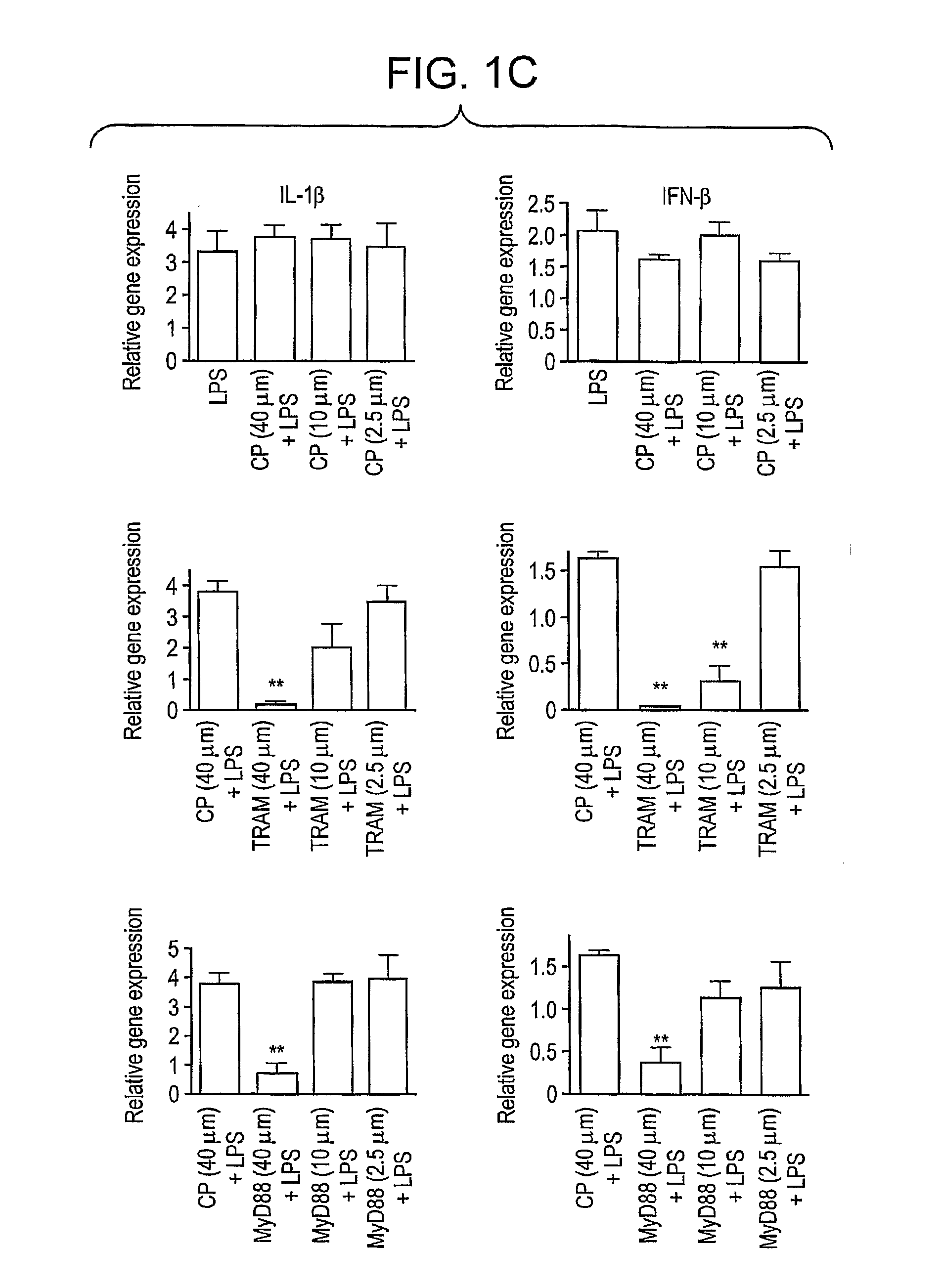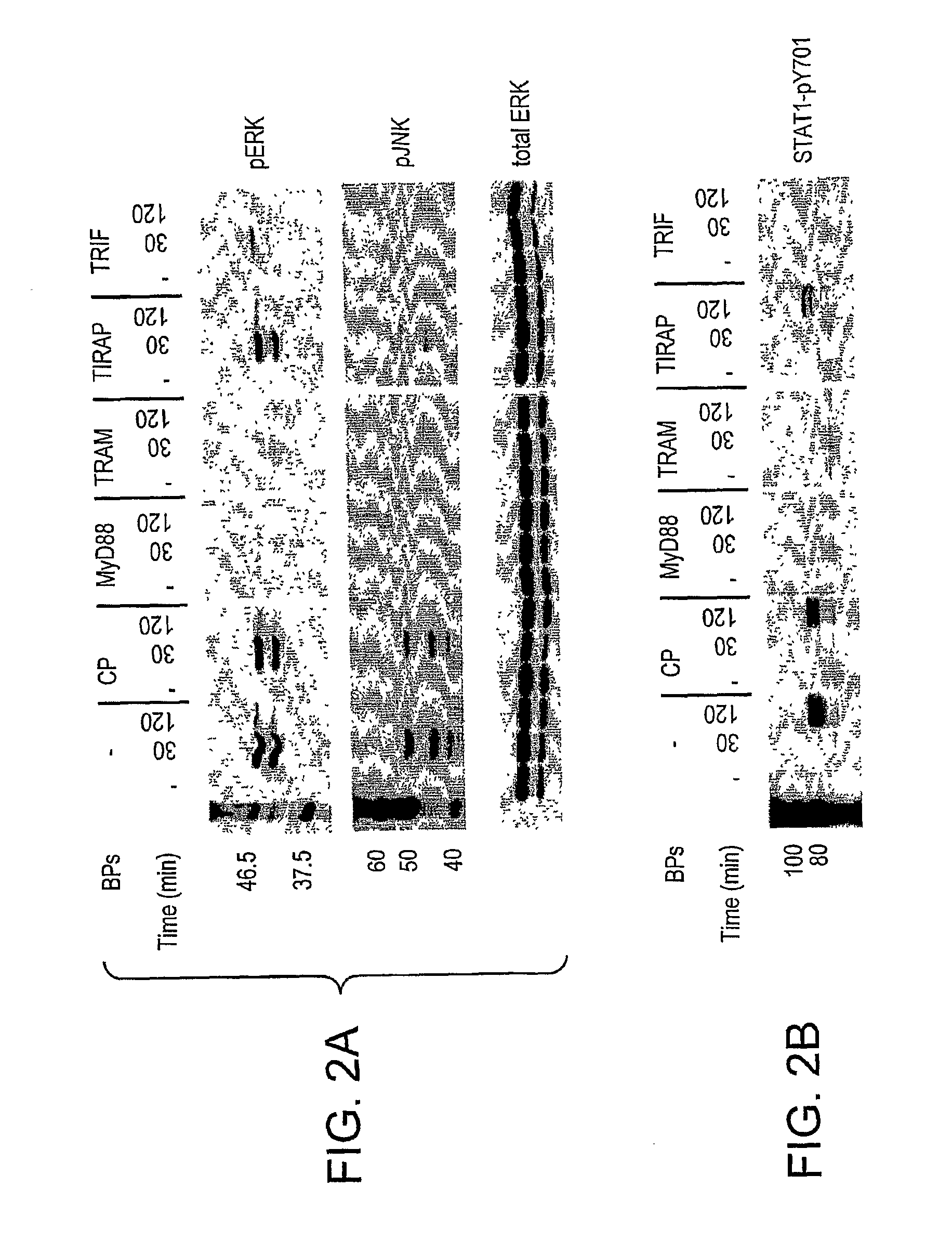Selective Inhibition of TLR4 Signaling
a tlr4 signaling and selective inhibition technology, applied in the direction of peptide/protein ingredients, peptide sources, drug compositions, etc., can solve the problem of failure to prevent induction of nf-b
- Summary
- Abstract
- Description
- Claims
- Application Information
AI Technical Summary
Benefits of technology
Problems solved by technology
Method used
Image
Examples
example 1
[0085]BB-Loop Peptides Block LPS-Induced Gene Expression in Primary Macrophages, but do not Distinguish Between MyD88-Dependent and Independent Pathways
[0086]Based on the observation that macrophages from MyD88 knockout mice do not synthesize TNF-α or IL-6 in response to LPS, while are still capable of inducing IFN-β and IFN-β-inducible genes (Kawai et al., 2001, J. Immunol. 167, 5587; Toshchakov et al., 2002, Nat. Immunol. 3, 392), two different signaling pathways propagating from TLR4 were defined (reviewed in Akira and Takeda, 2004, supra). The “MyD88-independent” pathway of TLR4 signaling utilizes TRAM and TRIF to activate IRF-3 that, in turn, leads to induction of IFN-β and IFN-β-inducible genes, while the “MyD88-dependent” pathway leads to induction of genes such as IL-1β, TNF-α, and IL-6 that do not depend on IRF-3 for their expression. Mice with targeted mutations in MyD88 (Kawai et al., 2001, supra; Toshchakov et al., 2002, supra) or TIRAP (Yamamoto et al., 2002, Nature 420...
example 2
Blocking Peptides Inhibit Activation of MAPKs by LPS
[0087]Since LPS-induced gene expression and cytokine secretion are consequences of signaling pathways induced by both the MyD88-dependent and independent signaling pathways, the data presented in FIG. 1 support the hypothesis that the BPs sequester and / or block target proteins of the adapter BB-loops that are essential for both arms of the TLR signaling pathway. Therefore, we next sought to examine upstream signaling pathways for their sensitivity to BPs.
[0088]MAPKs regulate various cellular functions including signal transduction from TLRs and their activation can be detected significantly earlier than gene expression or cytokine secretion. Using antibodies specific for the phosphorylated (activated) forms of JNK, ERK, and p38, we next sought to examine the effect of BB-loop-containing inhibitory peptides on LPS-stimulated activation of MAPKs. LPS induces quick and transient activation of MAPKs in primary macrophages (FIG. 2A) tha...
example 3
[0089]Effect of BB-Loop Blocking Peptides on Activation of STAT-1 by LPS
[0090]Signal transducer and activator of transcription-1 (STAT-1) propagates signal transduction emanating from both type I and type II interferon receptors (reviewed in Horvath, C. M. 2000, Trends Biochem. Sci. 25, 496). Two phosphate acceptor sites are involved in activation of STAT-1. While phosphorylation of Tyr701 is critical for homo- or heterodimerization and nuclear translocation of STAT-1, phosphorylation of Ser727 modulates its transcriptional activity (reviewed in Horvath, C. M., 2000, supra). We previously reported that tyrosine phosphorylation of STAT1 by LPS depends on MyD88-independent induction of IFN-β and the subsequent autocrine activation of type I interferon receptors (Toshchakov et al., 2002, supra).
[0091]LPS-induced Tyr701 phosphorylation of STAT-1 was strongly inhibited by the TRAM and TRIF blocking peptides (FIG. 2B). Consistent with its strong ability to block IFN-β gene expression (FIG...
PUM
| Property | Measurement | Unit |
|---|---|---|
| Permeability | aaaaa | aaaaa |
Abstract
Description
Claims
Application Information
 Login to View More
Login to View More - R&D
- Intellectual Property
- Life Sciences
- Materials
- Tech Scout
- Unparalleled Data Quality
- Higher Quality Content
- 60% Fewer Hallucinations
Browse by: Latest US Patents, China's latest patents, Technical Efficacy Thesaurus, Application Domain, Technology Topic, Popular Technical Reports.
© 2025 PatSnap. All rights reserved.Legal|Privacy policy|Modern Slavery Act Transparency Statement|Sitemap|About US| Contact US: help@patsnap.com



